Sony VAIO VGN-FZ31ER, VAIO VGN-FZ31E, VAIO VGN-FZ31MR, VAIO VGN-FZ31M, VAIO VGN-FZ31J User Manual
...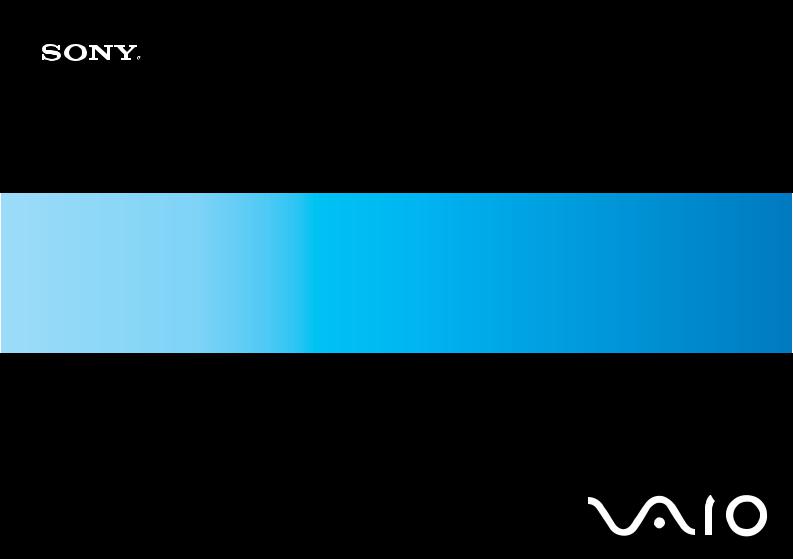
N
User Guide
Personal Computer
V G N - F Z s e r i e s

n 2 N
Contents |
|
Before Use ......................................................................................................................................................................... |
6 |
Notice........................................................................................................................................................................... |
7 |
Documentation............................................................................................................................................................. |
8 |
Ergonomic Considerations......................................................................................................................................... |
11 |
Getting Started ................................................................................................................................................................. |
13 |
Locating Controls and Ports....................................................................................................................................... |
14 |
About the Indicator Lights .......................................................................................................................................... |
20 |
Connecting a Power Source ...................................................................................................................................... |
21 |
Using the Battery Pack .............................................................................................................................................. |
22 |
Shutting Down Your Computer Safely ....................................................................................................................... |
28 |
Using Your VAIO Computer ............................................................................................................................................. |
29 |
Using the Keyboard ................................................................................................................................................... |
30 |
Using the Touch Pad ................................................................................................................................................. |
32 |
Using Special-function Buttons .................................................................................................................................. |
33 |
Using the Built-in MOTION EYE Camera................................................................................................................... |
35 |
Using the Optical Disc Drive ...................................................................................................................................... |
36 |
Using the ExpressCard Module ................................................................................................................................. |
46 |
Using the Memory Stick Media .................................................................................................................................. |
49 |
Using Other Memory Cards ....................................................................................................................................... |
55 |
Using the Internet....................................................................................................................................................... |
58 |
Using Wireless LAN (WLAN) ..................................................................................................................................... |
60 |
Using the Bluetooth Functionality .............................................................................................................................. |
67 |

n 3 N
Using Peripheral Devices................................................................................................................................................. |
73 |
Connecting External Speakers .................................................................................................................................. |
74 |
Connecting an External Display................................................................................................................................. |
75 |
Selecting Display Modes............................................................................................................................................ |
80 |
Using the Multiple Monitors Function......................................................................................................................... |
82 |
Connecting an External Microphone.......................................................................................................................... |
84 |
Connecting a Universal Serial Bus (USB) Device...................................................................................................... |
85 |
Connecting a Printer .................................................................................................................................................. |
88 |
Connecting an i.LINK Device ..................................................................................................................................... |
89 |
Connecting to a Network (LAN) ................................................................................................................................. |
91 |
Customizing Your VAIO Computer .................................................................................................................................. |
92 |
Setting the Password ................................................................................................................................................. |
93 |
Setting Up Your Computer with VAIO Control Center................................................................................................ |
96 |
Using the Power Saving Modes................................................................................................................................. |
97 |
Managing Power with VAIO Power Management.................................................................................................... |
102 |
Configuring Your Modem ......................................................................................................................................... |
103 |
Upgrading Your VAIO Computer.................................................................................................................................... |
105 |
Adding and Removing Memory................................................................................................................................ |
106 |

n 4 N
Precautions .................................................................................................................................................................... |
112 |
On Handling the LCD Screen .................................................................................................................................. |
113 |
On Using the Power Source .................................................................................................................................... |
114 |
On Handling Your Computer.................................................................................................................................... |
115 |
On Using the Built-in MOTION EYE Camera........................................................................................................... |
117 |
On Handling Floppy Disks ....................................................................................................................................... |
118 |
On Handling Discs ................................................................................................................................................... |
119 |
On Using the Battery Pack....................................................................................................................................... |
120 |
On Using Headphones............................................................................................................................................. |
121 |
On Handling Memory Stick Media............................................................................................................................ |
122 |
On Handling the Hard Disk ...................................................................................................................................... |
123 |
On Updating Your Computer ................................................................................................................................... |
124 |
Troubleshooting ............................................................................................................................................................. |
125 |
Computer ................................................................................................................................................................. |
126 |
System Security ....................................................................................................................................................... |
133 |
Battery...................................................................................................................................................................... |
134 |
Built-in MOTION EYE Camera................................................................................................................................. |
136 |
Internet..................................................................................................................................................................... |
139 |
Networking ............................................................................................................................................................... |
141 |
Bluetooth Technology .............................................................................................................................................. |
144 |
Optical Discs ............................................................................................................................................................ |
148 |
Display ..................................................................................................................................................................... |
153 |
Printing..................................................................................................................................................................... |
158 |
Microphone .............................................................................................................................................................. |
159 |

n 5 N
Mouse ...................................................................................................................................................................... |
160 |
Speakers.................................................................................................................................................................. |
161 |
Touch Pad................................................................................................................................................................ |
163 |
Keyboard.................................................................................................................................................................. |
164 |
Floppy Disks ............................................................................................................................................................ |
165 |
Audio/Video.............................................................................................................................................................. |
166 |
Memory Stick Media ................................................................................................................................................ |
169 |
Peripherals............................................................................................................................................................... |
170 |
Support Options ............................................................................................................................................................. |
171 |
Sony Support Information ........................................................................................................................................ |
171 |
e-Support ................................................................................................................................................................. |
172 |
Trademarks.............................................................................................................................................................. |
174 |

n 6 N
Before Use
Before Use
Congratulations on your purchase of this Sony VAIO® computer, and welcome to the on-screen User Guide. Sony has combined leading-edge technology in audio, video, computing, and communications to provide state-of-the-art personal computing experience.
!
External views illustrated in this manual may look slightly different from those of your computer.

n 7 N
Before Use
Notice
© 2008 Sony Corporation. All rights reserved.
This manual and the software described herein, in whole or in part, may not be reproduced, translated, or reduced to any machine-readable form without prior written approval.
Sony Corporation provides no warranty with regard to this manual, the software, or other information contained herein and hereby expressly disclaims any implied warranties or merchantability or fitness for any particular purpose with regard to this manual, the software, or such other information. In no event shall Sony Corporation be liable for any incidental, consequential, or special damages, whether based on tort, contract, or otherwise, arising out of or in connection with this manual, the software, or other information contained herein or the use thereof.
In the manual, the ™ or ® marks are not specified.
Sony Corporation reserves the right to make any modification to this manual or the information contained herein at any time without notice. The software described herein is governed by the terms of a separate user license agreement.

n 8 N
Before Use
Documentation
Your documentation includes printed information and user guides to read on your VAIO computer.
Printed Documentation
Quick Start Guide — Describes the process from unpacking to starting up your VAIO.
Troubleshooting and Recovery Guide — Contains solutions to common problems and computer malfunctions, an explanation of how to make a backup copy of your data and recover your computer system, and sources of support information.
Instant Mode* — Provides a guide to use Instant Mode.
*On models with the NVIDIA video controller only.
Regulations, Warranty, EULA and Service Support — Contains Sony guarantee conditions, safety / regulations, modem regulations, wireless LAN regulations, wireless WAN regulations, Bluetooth regulations, end user software license agreement, and Sony support services information.

n 9 N
Before Use
Non-printed Documentation
User Guide (this manual) — Explains features of your computer. It also includes information about the software programs included with your computer, as well as information on solving common problems. User Guide is provided in the PDF format, which you can easily browse through and print out.
To view this on-screen guide:
1 Double-click the VAIO User Guide icon on the desktop.
2 Open the folder for your language.
3 Select the guide you want to read.
You can manually browse to the user guides by going to Computer > VAIO (C:) (your C drive) > Documentation > Documentation and opening the folder for your language.
To go to Web sites described in this manual by clicking their respective URLs beginning with http://, your computer must be connected to the Internet.
Specifications — The online specifications describe the hardware and software configurations of your VAIO computer. To view the online specifications:
1 Connect to the Internet.
2 Go to the Sony online support Web site at http://www.vaio-link.com.
You may have a separate disc for the documentation of bundled accessories.

n 10 N
Before Use
My Club VAIO
In My Club VAIO you can find:
Accessories
Want to expand the capabilities of your computer? Click this icon and have a look at your compatible accessories.
Software
Feeling creative? Click this icon for an overview of your software and check out our upgrade options.
Wallpapers
Click this icon and check out our most popular Sony and Club VAIO wallpapers.
Links
Click this icon and check out our most popular Sony and Club VAIO Web sites.
Windows Help and Support
Windows Help and Support is a comprehensive resource for practical advice, tutorials, and demonstrations to help you learn to use your computer.
Use the Search feature, Index, or table of contents to view all Windows Help resources, including those that are on the Internet.
To access Windows Help and Support, click Start  and Help and Support. Or go to Windows Help and Support by pressing and holding the Microsoft Windows key and pressing the F1 key.
and Help and Support. Or go to Windows Help and Support by pressing and holding the Microsoft Windows key and pressing the F1 key.
Further Sources
Consult the help files on the software you are using for detailed information on features and troubleshooting.
Go to http://www.club-vaio.com to find online tutorials about your favorite VAIO software.
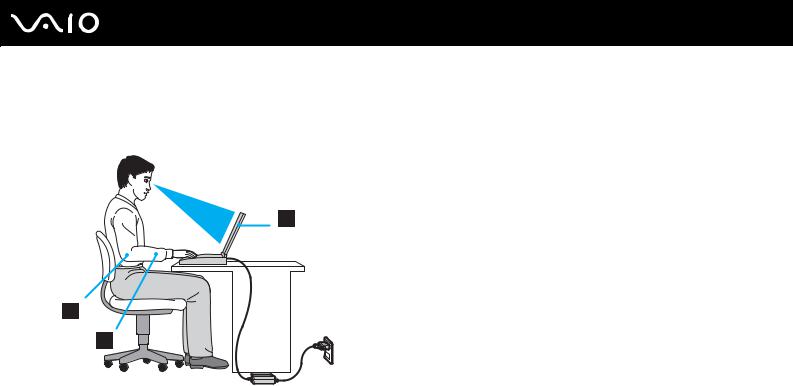
n 11 N
Before Use
Ergonomic Considerations
You will be using your computer as a portable device in a variety of environments. Whenever possible, you should attempt to take account of the following ergonomic considerations for both stationary and portable environments:
Position of your computer – Place the computer directly in front of you (1). Keep your forearms horizontal (2), with your wrists in a neutral, comfortable position (3) while using the keyboard, touch pad, or external mouse. Let your upper arms hang naturally at your sides. Have breaks during sessions with your computer. Excessive use of the computer may strain eyes, muscles, or tendons.
Furniture and posture – Sit in a chair with good back support. Adjust the level of the chair so your feet are flat on the floor. A footrest may make you more comfortable. Sit in a relaxed, upright posture and avoid slouching forward or leaning far backwards.

n 12 N
Before Use
Viewing angle of the computer's display – Use the display's tilting feature to find the best position. You can reduce eye strain and muscle fatigue by adjusting the tilt of the display to the proper position. Adjust the brightness level of the display as well.
Lighting – Choose a location where windows and lights do not cause glare and reflection on the display. Use indirect lighting to avoid bright spots on the display. Proper lighting adds to your comfort and work efficiency.
Positioning an external display – When using an external display, set the display at a comfortable viewing distance. Make sure the display screen is at eye level or slightly lower when you are sitting in front of the monitor.

n 13 N
Getting Started
Getting Started
This section describes how to get started using your VAIO computer.
Locating Controls and Ports (page 14)
About the Indicator Lights (page 20)
Connecting a Power Source (page 21)
Using the Battery Pack (page 22)
Shutting Down Your Computer Safely (page 28)

n 14 N
Getting Started
Locating Controls and Ports
Take a moment to identify the controls and ports shown on the following pages.
Front
A Built-in MOTION EYE camera (page 35)
B Built-in MOTION EYE camera indicator (page 20)
C Built-in microphone (monaural)
D LCD screen (page 113)
E Built-in speakers (stereo)
F Num lock indicator (page 20)
G Caps lock indicator (page 20)
H Scroll lock indicator (page 20)
I Keyboard (page 30)
J Touch pad (page 32)
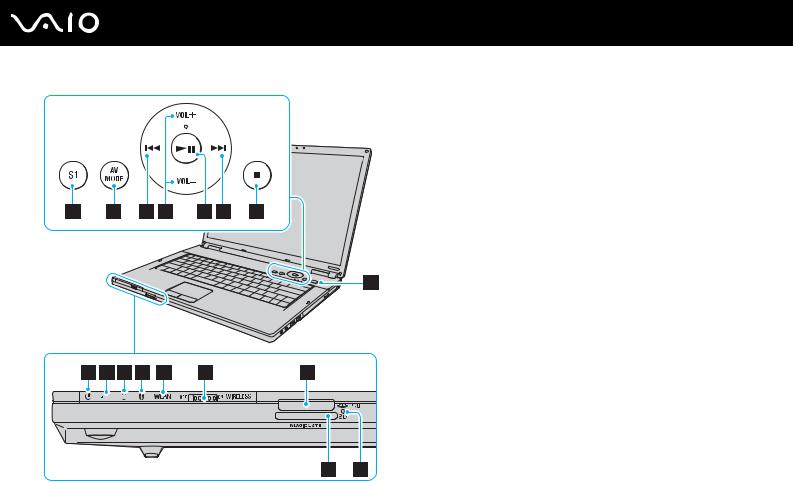
n 15 N
Getting Started
A S1 button (page 33)
B AV MODE button (page 33)
C Previous track button (page 33)
D VOL-/VOL+ buttons (page 33)
E Play/Pause button (page 33)
F Next track button (page 33)
G Stop button (page 33)
H Power button
I Power indicator (page 20)
J Battery indicator (page 20)
K Hard disk drive indicator (page 20)
L Bluetooth indicator (page 20)
M WLAN (Wireless LAN) indicator (page 20)
N WIRELESS switch (page 60)
O Memory Stick slot* (page 51)
P SD memory card slot (page 55)
Q Media Access indicator (page 20)
*Your computer supports both standardand Duo-size Memory Stick media.
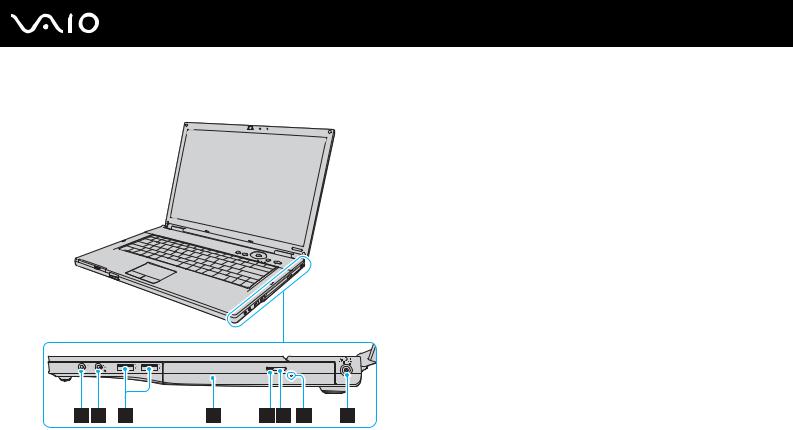
n 16 N
Getting Started
Right
A Headphones jack (page 74)
B Microphone jack (page 84)
C Hi-Speed USB (USB 2.0) ports* (page 85)
D Optical disc drive (page 36)
E Optical disc drive indicator (page 20)
F Drive eject button (page 36)
G Manual eject hole (page 148)
H DC IN port (page 21)
* Support high-/full-/low- speeds.
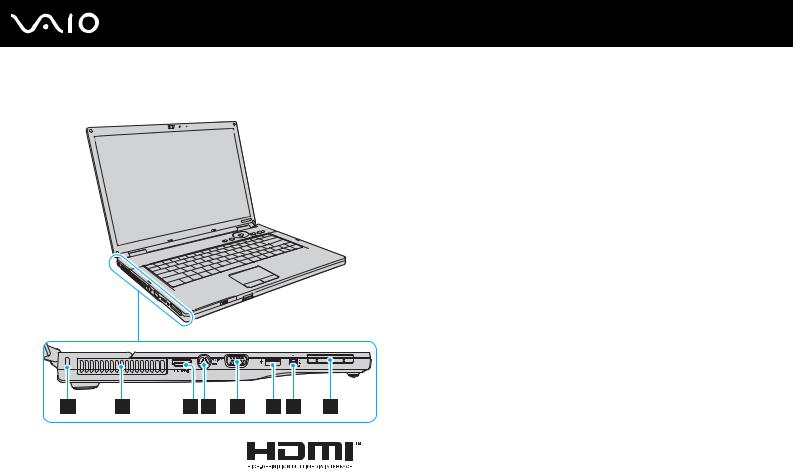
n 17 N
Getting Started
Left
A Security slot
B Air vent
C HDMI port*1 (page 75)
D S VIDEO OUT port (page 77)
E Monitor (VGA) port (page 75)
F Hi-Speed USB (USB 2.0) port*2 (page 85)
G i.LINK (IEEE 1394) S400 port (page 89)
H ExpressCard/34 slot (page 46)
*1 On models with the NVIDIA video controller only.
*2 Supports high-/full-/low- speeds.
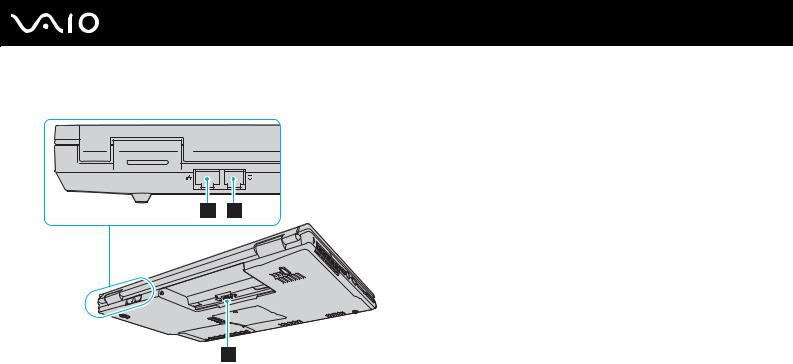
n 18 N
Getting Started
Back
A Network (Ethernet) port (page 91)
B Modem port (page 58)
C Battery connector
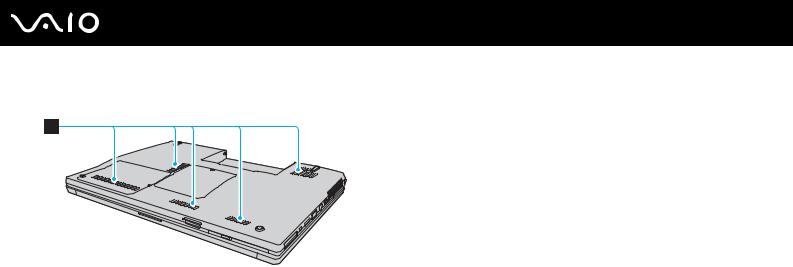
n 19 N
Getting Started
Bottom
A Air vents

n 20 N
Getting Started
About the Indicator Lights
Your computer is equipped with the following indicator lights.
Indicator |
Functions |
|
|
|
|
Power 1 |
Illuminates when the power of the computer is on, blinks when the computer is in Sleep mode, and turns off |
|
|
when the computer is in Hibernate mode or off. |
|
|
|
|
Battery e |
Illuminates when the computer is using battery power, blinks when the battery pack is running out of power, and |
|
|
double-blinks when the battery pack is charging. |
|
|
|
|
Built-in MOTION EYE camera |
Illuminates while the built-in MOTION EYE camera is in use. |
|
|
|
|
Media Access |
Illuminates when data is read from or written to a memory card. (Do not enter Sleep mode or turn off the |
|
|
computer when this indicator is on.) When the indicator is off, the memory card is not being used. |
|
|
|
|
Optical disc drive |
Illuminates when data is read from or written to the optical disc media. When the indicator is off, the optical disc |
|
|
media is not being used. |
|
|
|
|
Hard disk drive |
Illuminates when data is read from or written to the hard disk drive. Do not enter Sleep mode or turn off the |
|
computer when this indicator is on. |
||
|
||
|
|
|
Num lock |
Press the Num Lk key to activate the numeric keypad. Press it a second time to deactivate the numeric keypad. |
|
The numeric keypad is not active when the indicator is off. |
||
|
||
|
|
|
Caps lock |
Press the Caps Lock key to type letters in uppercase. Letters appear in lowercase if you press the Shift key |
|
while the indicator is on. Press the key a second time to turn off the indicator. Normal typing resumes when the |
||
|
||
|
Caps lock indicator is off. |
|
|
|
|
Scroll lock |
Press the Scr Lk key to change how you scroll the display. Normal scrolling resumes when the Scroll lock |
|
indicator is off. The Scr Lk key functions differently depending on the program you are using and does not work |
||
|
||
|
with all programs. |
|
|
|
|
Bluetooth technology |
Illuminates when the WIRELESS switch is set to ON and Bluetooth technology is enabled. |
|
|
||
|
|
|
Wireless LAN |
Illuminates when the wireless LAN functionality is enabled. |
|
|
|
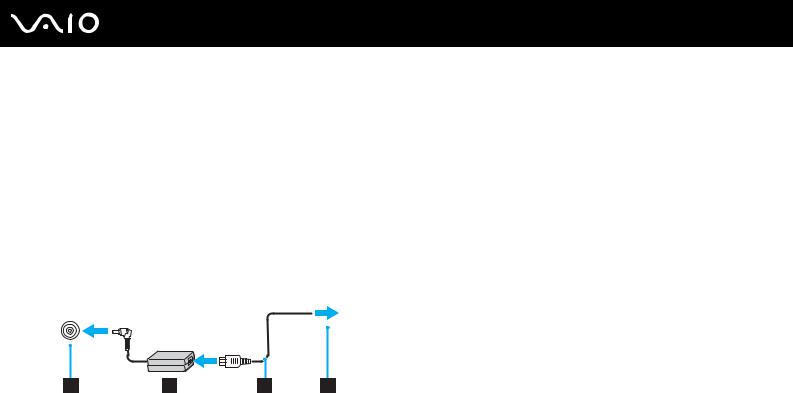
n 21 N
Getting Started
Connecting a Power Source
You can use either an AC adapter or a rechargeable battery pack as a power source for your computer.
Using the AC Adapter
Use your computer only with the supplied AC adapter.
To use the AC adapter
1Plug one end of the power cord (1) into the AC adapter (3).
2Plug the other end of the power cord into an AC outlet (2).
3Plug the cable connected to the AC adapter (3) into the DC IN port (4) on the computer.
!
The shape of the DC In plug varies depending on the AC adapter.
To disconnect your computer completely from AC power, unplug the AC adapter.
Make sure that the AC outlet is easily accessible.
If you do not intend to use your computer for a long period of time, place the computer into Hibernate mode. See Using Hibernate Mode (page 100). This power saving mode saves the time of shutting down and resuming.
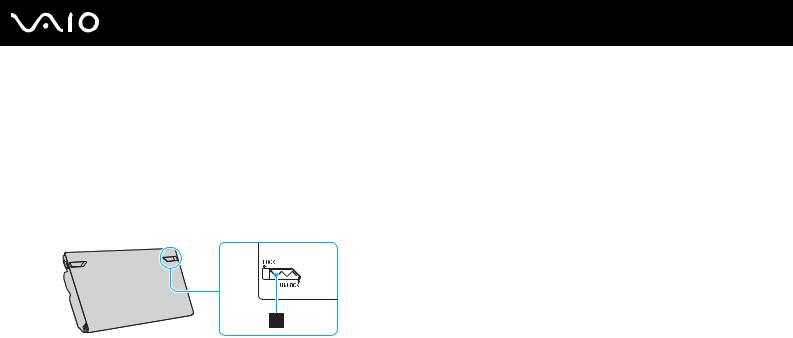
n 22 N
Getting Started
Using the Battery Pack
The battery pack supplied with your computer is not fully charged at the time of delivery.
Installing the Battery Pack
To install the battery pack
1Turn off the computer and close the LCD screen lid.
2Slide the battery LOCK/UNLOCK switch (1) to the UNLOCK position.
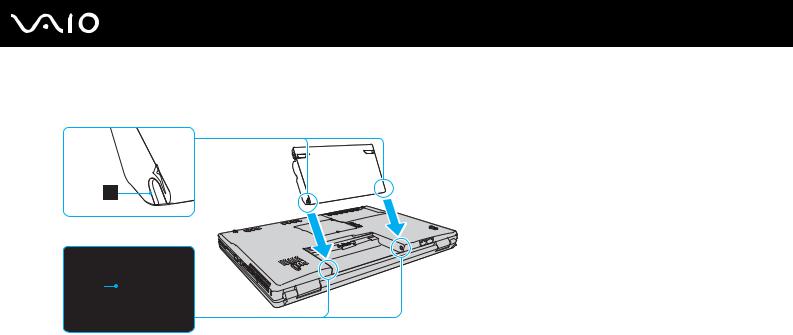
n 23 N
Getting Started
3Slide the battery pack diagonally into the battery compartment until the projections (2) on either side of the battery compartment fit into the U-shaped cuts (3) on either side of the battery pack.

n 24 N
Getting Started
4Rotate the battery pack in the direction of the arrow, and push the battery pack down into the compartment until it clicks into place.
5 Slide the battery LOCK/UNLOCK switch to the LOCK position to secure the battery pack on the computer.
When your computer is directly connected to AC power and has a battery pack installed, it uses power from the AC outlet.
!
Certain rechargeable batteries do not meet Sony quality and safety standards. For safety reasons this computer only functions with genuine Sony batteries designed for this model. When installing another kind of battery, the battery will not be charged and the computer will not function.
Be sure to slide the battery LOCK/UNLOCK switch to the LOCK position before using your computer.

n 25 N
Getting Started
Charging the Battery Pack
The battery pack supplied with your computer is not fully charged at the time of delivery.
To charge the battery pack
1Install the battery pack.
2Connect the AC adapter to the computer.
The computer automatically charges the battery pack (the battery indicator light flashes in a double blink pattern as the battery pack charges). When the battery pack is about 85% charged, the battery indicator turns off.
Battery indicator light status |
Meaning |
|
|
On |
The computer is using battery power. |
|
|
Blinks |
The battery pack is running out of power. |
|
|
Double blinks |
The battery pack is charging. |
|
|
Off |
The computer is using AC power. |
|
|

n 26 N
Getting Started
!
Charge the battery pack as described in this manual from your first battery charge.
When the battery pack is running out of power, both the battery and power indicator lights blink.
Keep the battery pack in your computer while it is directly connected to AC power. The battery pack continues to charge while you are using the computer.
If the battery level falls below 10%, you should either connect the AC adapter to recharge the battery pack or shut down your computer and install a fully charged battery pack.
The battery pack supplied with your computer is a lithium ion battery pack and can be recharged any time. Charging a partially discharged battery pack does not affect the battery life.
The battery indicator light is on while you use the battery pack as a power source. When battery life is nearly depleted, both the battery and power indicator lights start flashing.
For some software applications and some peripheral devices, your computer may not enter Hibernate mode even when battery life is low. To avoid loss of data when using battery power, you should save your data frequently and manually activate a power management mode, such as Sleep or Hibernate.
If the battery pack wears out when the computer enters Sleep mode, you will lose all unsaved data. Going back to the previous work state is impossible. To avoid loss of data, you should save your data frequently.
When your computer is directly connected to AC power and has a battery pack installed, it uses power from the AC outlet.
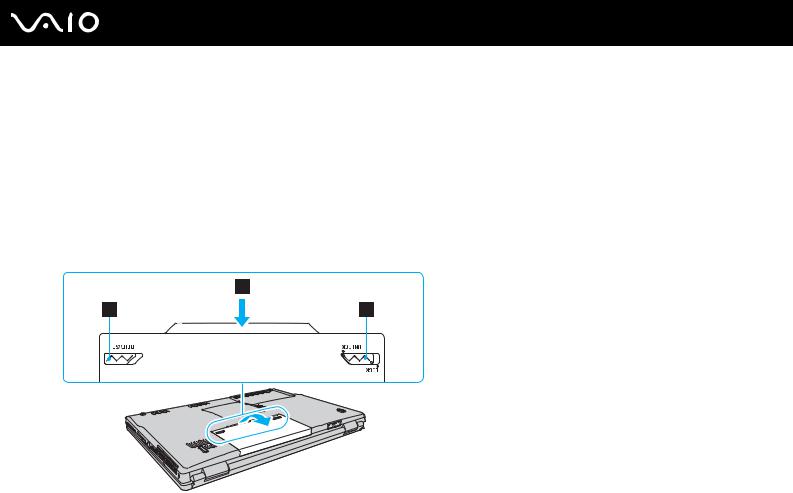
n 27 N
Getting Started
Removing the Battery Pack
!
You may lose data if you remove the battery pack while your computer is on and not connected to the AC adapter or if you remove the battery pack while the computer is in Sleep mode.
To remove the battery pack
1Turn off the computer and close the LCD screen lid.
2Slide the battery LOCK/UNLOCK switch (1) to the UNLOCK position.
3Slide and hold the battery RELEASE latch (2), hook your fingertip under the tab (3) on the battery pack, and turn the battery pack in the direction of the arrow, and then slide it away from the computer.

n 28 N
Getting Started
Shutting Down Your Computer Safely
To avoid losing unsaved data, be sure to shut down your computer properly, as described below.
To shut down your computer
1Turn off any peripherals connected to the computer.
2Click Start, the arrow  next to the Lock button, and Shut Down.
next to the Lock button, and Shut Down.
3Respond to any prompts warning you to save documents or to consider other users and wait for the computer to turn off automatically.
The power indicator light turns off.

n 29 N
Using Your VAIO Computer
Using Your VAIO Computer
This section describes how to get the most out of using your VAIO computer.
Using the Keyboard (page 30)
Using the Touch Pad (page 32)
Using Special-function Buttons (page 33)
Using the Built-in MOTION EYE Camera (page 35)
Using the Optical Disc Drive (page 36)
Using the ExpressCard Module (page 46)
Using the Memory Stick Media (page 49)
Using Other Memory Cards (page 55)
Using the Internet (page 58)
Using Wireless LAN (WLAN) (page 60)
Using the Bluetooth Functionality (page 67)

n 30 N
Using Your VAIO Computer
Using the Keyboard
Your keyboard is very similar to a desktop computer keyboard, but has additional keys that perform model-specific tasks.
The VAIO-Link Web site (http://www.vaio-link.com) also contains glossary information to help you use the keyboard.
Combinations and Functions with the Fn Key
Some keyboard functions can be used only after the operating system finished launching.
Combinations/Feature |
Functions |
|
|
|
|
Fn + % (F2): speaker switch |
Turns on and off the built-in speakers and the headphones. |
|
|
|
|
Fn + 8 (F5/F6): brightness control |
Adjusts the LCD brightness of your computer screen. |
|
|
|
To increase lighting intensity, press Fn+F6 and then M or ,, or keep pressing Fn+F6. |
|
|
To decrease lighting intensity, press Fn+F5 and then m or <, or keep pressing Fn+F5. |
|
|
|
Fn + |
/T (F7): display output |
Toggles among your computer screen, an external display, and simultaneous output to both. |
|
||
|
|
|
